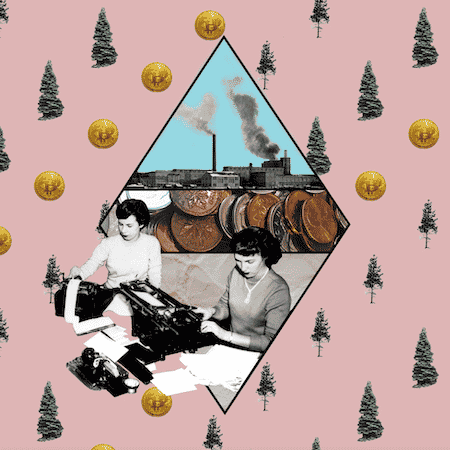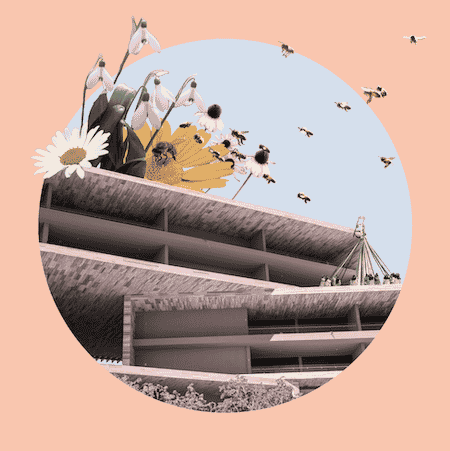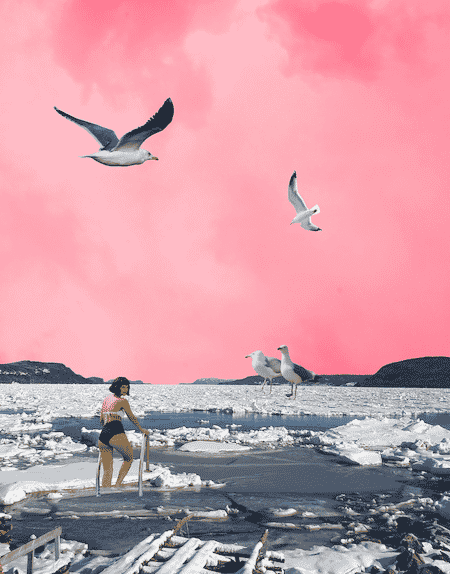What’s one tool Nicole Holloway can’t live without? The library! The artist from Newfoundland, Canada, researches narratives and sources images in the stacks before creating her mixed-media and digital collages. Her narrative-driven work explores feminism, the environment, Newfoundland’s singular terrain, and more through a personal lens. Her pro tip: Befriend your local librarian to get first dibs on discarded materials you can repurpose. Learn more about Holloway’s inspiration and process below.

Nicole Holloway lives and works in Newfoundland, Canada.
Tell us about your journey to becoming an artist. When did the visual arts become a passion for you? When did you decide to pursue the arts professionally?
I like to think I’ve always been a creative person. I knew going into high school that I wanted to get a visual arts degree. I never even considered anything else. Looking back now, I don’t think I actually knew what I wanted to do with the degree, I only knew I wanted one. When people would ask me about the future, I would usually say I wanted to teach because most of my friends in art school were planning to do that. In retrospect, I’m glad I didn’t know because it allowed me to just do what interested me in the moment. In art school, I focused on two-dimensional design, like painting and printmaking. I got hired at a flower shop after I graduated and apprenticed with the owner for about four years. That job really helped me branch out with my artwork and not be afraid of adding form and shape to my work.
Most recently, you’ve been working in collage. How does your process go from idea to execution? How do you know when a work is “finished”?
I work in an academic library, so I like to start with research. The library is shelved by subject, and I love walking up and down the book stacks and borrowing books that connect with my chosen subject matter in exciting ways. Once I pick my research material, I look for artistic material. Most of my digital stuff comes from royalty-free image websites. For physical collages, I check the library for discarded books with pictures in them. I’ve also befriended the librarian at the public library, and she’ll usually call me when they discard their magazines.
I like to start by reading through my research material, so I can get a better understanding of my subject matter. The more I research the subject, the easier it is to narrow down my imagery and build a design that feels appropriate. I use Photoshop for my digital work. My paper collages are done with scissors, an exacto-knife, and a glue stick (usually pilfered from my kid’s craft box). I also like using different materials for my collages too, like found objects and ocean debris, all kinds of stuff.
Finishing a piece is tricky for me sometimes, I rarely know exactly when to stop. I tend to add too much to a work, reconsider, remove pieces, and stare at it for a long time. I also like to give myself a day or two to sit with it before I finally put it out into the world.

“Single Ladies” by Nicole Holloway pays homage to Newfoundland’s Great Depression-era women who, unable to work due to being married, found meaning by contributing to the greater good.
How do your personal narratives intersect with political narratives in your work?
I use my work to express an idea or opinion on something, and I like to weave a personal narrative into my work because it’s a representation of me and my ideas. When I’m dealing with broad subjects like feminism, politics, or the environment, it’s easier to relate it back to my situation. A lot of those personal narratives involve spirituality, where I live (Newfoundland, Canada), and my ideas and opinions on the future.
How do you find a “resolution” to some of these issues?
I like to combine the images I find with the principles and elements of design that visually reinforce the message behind the piece. Presenting an idea in an aesthetically pleasing way will make people spend more time considering it, because it can appeal to their visual sense. They may not agree with the message, but they can appreciate the way in which the message is presented, lending weight to the idea. In my recent body of work, we’ve gone so far, we’ve come full circle, I used the circle shape to unify each work, colour to emphasize the season and position in the sequence, and used repeated imagery in each work to reinforce my message.

“No. 4 (Beltane) Let Me Tell Ya ‘Bout the Birds and the Bees” depicts a potential future in which Mother Nature reclaims her place.
Describe the studio environment you create in. Do you have any rituals to get in the zone? Do you have a mantra or a motto?
Hollow Hill Studio is a name I came up with for my artistic practice that combines my last name with hill, because our first house was on the edge of this steep hill that went down to a big waterfall behind our house. I used to work in my dining room there, and stare at the waterfall as I painted. We moved to a bigger house in 2020, and my studio is technically in the spare bedroom. There’s lots of storage in there for materials and space to set up my easel if I need it. Everything else is pretty much still done at the dining room table though, or the family computer in the living room. Since I work full time and have kids, getting studio time can be difficult. I always tell myself to aim for 30 minutes of “studio time” every day. The way I see it, half an hour is always doable. I always look forward to sitting down with some coffee or tea and puttering away at something for a while.
When do you feel most creative? How do you boost your creativity and push through creative blocks?
I’m a morning person, but unfortunately my schedule only allows me to work on art in the evenings. If I’m not able to work on art until after supper, I usually find myself going over the concepts during the day and refining the message I want to send. That way when I’m working in the evenings, I can focus on the mundane tasks like cutting, assembling, etc. If I’m stuck creatively, I like to go back to the original idea and re-examine the research.
What is one tool you could not live without?
I would say my computer, but that seems too obvious. I know this seems cheesy, but the library is a tool I use all the time. Not only for research, but for the sheer volume of free material I’ve gotten from librarians after they’ve weeded their collections. Books, magazines, all kinds of stuff.

“It’s a Different Kind of Cold” celebrates Newfoundland’s isolated landscape and rugged inhabitants.
Who are your influences?
I really love art that’s more conceptual or contemporary. In art school, I was influenced a lot by artists like Marcel Duchamp, Jenny Holzer, Tony Cragg, Cornelia Parker and Rachel Whiteread. I’m also a fan of Petah Coyne, and some contemporary artists like Elyse Dodge, Natalie Ciccoricco, Nneka Jones and Sara Khan.
What subjects are fascinating you most right now?
Lately I’ve been really hung up on the idea of utopia, and how the different components of a utopian society are perceived based on the community’s needs. It’s such a broad subject, with so many different approaches.
What do you hope audiences feel when they see your work?
The goal of my artwork is always to create possibility and courage in the face of frustration and despair. It’s a personal journey to understand current issues facing our society. I want to create positive potential outcomes that can bolster people’s faith in our collective future.
Find more of Nicole’s work
here.
